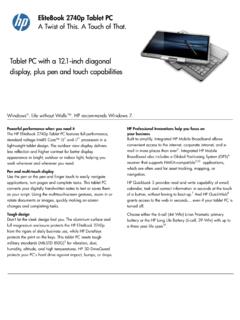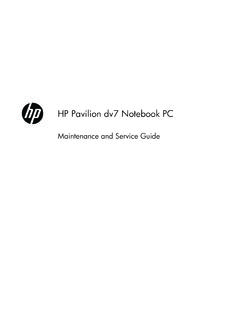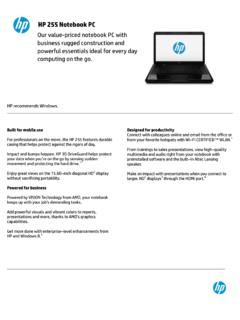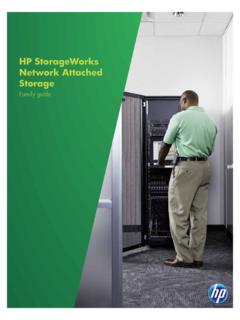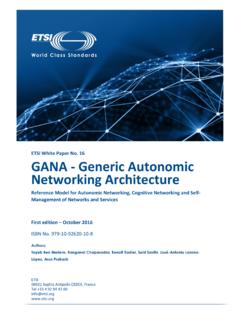Transcription of Network functions virtualization - Technical white …
1 Technical white paper Network functions virtualization Table of contents Introduction .. 2 NFV building on key enterprise IT trends and technologies .. 3 NFV is a catalyst for structural market change .. 4 HP s leadership role in NFV .. 6 HP s architectural point of view .. 7 NFV adoption .. 9 Conclusion .. 10 Acronyms .. 11 Technical white paper | Network functions virtualization 2 Introduction Network functions virtualization (NFV) is a core structural change in the way telecommunication infrastructure gets deployed. This in turn will bring significant changes in the way that applications are delivered to service providers. NFV will bring cost efficiencies, time-to-market improvements and innovation to the telecommunication industry infrastructure and applications.
2 NFV will achieve this through disaggregation of the traditional roles and technology involved in telecommunications applications. This disaggregation will be enabled by changing the industry s traditional approach to delivery of applications from a closed, proprietary, and tightly integrated stack model into an open, layered model, where applications are hosted on a shared, common infrastructure base. This paper reflects HP s view on how cost will be reduced and how major innovations will be introduced as NFV is adopted. The associated dynamics will be analogous to the dynamics that enterprise IT has undergone over the last decade, and its associated benefits. NFV brings these market dynamics and efficiencies to the core revenue-generating applications of telecommunications.
3 The requirements and open standards that underpin NFV are being developed by an ETSI Industry Specification Group (ISG). HP has several contributing members in this group. This paper also outlines HP s view on the roadmap to NFV, including the evolution of role(s) of different types of vendors in the market structure. We specifically highlight the architectural principles HP will promote to secure its customers the most value, and therefore competitive edge, in a world of increasing competition. The open architecture described in this paper has two key modules the NFV infrastructure, realized with HP Converged Infrastructure, and the hypervisor-independent NFV Orchestrator, based on elements of HP s converged cloud. The architecture delivers a vision for an open solution that ensures our customers can access the best technologies to deploy NFV.
4 The architecture has a deep alignment with Software Defined Networking (SDN) and specifically HP s developments in this area. HP s NFV architecture is based on a layered approach that allows our customers to incrementally add new functionality and also gives customers the openness and flexibility to work with the tools and vendors they prefer. For the infrastructure layer, we provide pre-integrated, workload-optimized systems to run virtualized functions on the carrier Network , based upon the latest technologies in easy-to-buy, manage, and support models. We support various deployments of hypervisors with SRVIO/DPDK, providing ISVs and CSPs a way to achieve line rate networking performance on HP servers. This allows carriers to run their networks with the same hardware that IT uses.
5 Our converged infrastructure management solution of OneView provides a single, collaborative management platform built for speed. It allows IT/ Network teams to work and collaborate in a more natural and automated way. It s a software-based approach to lifecycle management that automates operations to reduce the cost and time to deliver IT services with an open development platform designed to rapidly adapt to business needs. This programmable platform, built on the REST API, allows you to scale beyond your data center walls to the cloud. At the Network virtualization layer we believe that SDN controllers will increasingly need to support both virtual and physical networks. This is a key design goal consideration, and HP s solution provides automated provisioning of both physical and Technical white paper | Network functions virtualization 3 virtual networks.
6 In addition to overlay support, physical switches support both layer 2 and layer 3 forwarding plus flows, which will enable bridges between SDN and non-SDN implementations. An all-encompassing management platform such as HP s IMC will be imperative to the successful deployment of an SDN solution in heterogeneous environments, and it is our aim to bring this ease of management to our customers. HP CloudSystem delivers a simple, proven path to the NFV infrastructure as a service (IaaS). It supports multiple hypervisors and enables consumers to access private clouds and virtual resources. It features: Simple infrastructure services provisioned within minutes, leveraging HP s Cloud OS software Open APIs including OpenStack APIs provided for both administrative and cloud service functions , enabling highlyautomated cloud delivery.
7 New administration console, aligned with HP OneView an infrastructure management tool designed from the ground up for convergence, and for managing all HP Converged Infrastructure Fast and easy installation via software appliance delivery model HP, with its strong heritage in management software, has rich portfolio offerings to support carriers in their journey to integrate the entire NFV stack into their existing OSS/BSS solutions. Our solutions range from traditional fault management to complex services-based management supporting the complete FCAPS needs for our carriers. Finally our NFV Director is the HP implementation of the NFV Orchestration (NFVO) functionality from the emerging ETSI model. This NFV Orchestration function is critical to the actual operationalization of NFV.
8 Ensuring the capability to manage NFV in heterogeneous, multi-vendor, and geographically distributed environments is a key differentiator for HP. HP brings our deep experience and expertise in both Telco and IT to ensure HP NFV Director addresses all the key functionality required. NFV building on key enterprise IT trends and technologies One lens we can look through to understand the future of NFV is a view on what has happened in enterprise IT. NFV uses traditional IT virtualization techniques on commodity hardware (compute, storage, and networking) to consolidate Network applications onto industry high-volume servers and storage and hence allows the industry to gain from both the cost and innovation dynamics of traditional IT. It is possible today to use COTS IT Infrastructure to do complex tasks that have traditionally required custom hardware builds on specialized ASIC or DSP devices (thanks to recent technologies such as the packet processing capabilities found in the latest CPUs).
9 Within enterprise IT applications, server and storage sprawl and complexity cause most organizations to spend more than 70% of their budget and resources on maintenance and operations and less than 30% of time and money on innovation on the things that help the business be more competitive. As a result, most IT organizations have seen a widening gap between what the business demands and what IT can deliver. They lack the agility to respond to business requests in a timely manner. At HP, we believe that the only way for enterprise IT and networks to shift resources from operations to innovation is through infrastructure convergence. HP Converged Infrastructure is a blueprint for the data center of the future that accelerates the provisioning of IT services and applications by integrating servers, storage, networking, security, power, cooling, and facilities into shared pools of interoperable resources, all managed through a common management platform.
10 The first step for most organizations has been one of standardization to increase quality and speed of IT service delivery with lower cost of operations and better, more efficient management. This could include moving to a small number of approved standard configurations, based on industry standards with reusable components and implemented in a consistent fashion with consistent management tools. The end result of this step is a more standards-based, modular, and reusable infrastructure. The second step for IT has been one of virtualization , moving from physical server, storage and networking environments to virtualizing the entire data center, increasing the quality of the service delivered and making IT more responsive and aligned to the needs of the business.

